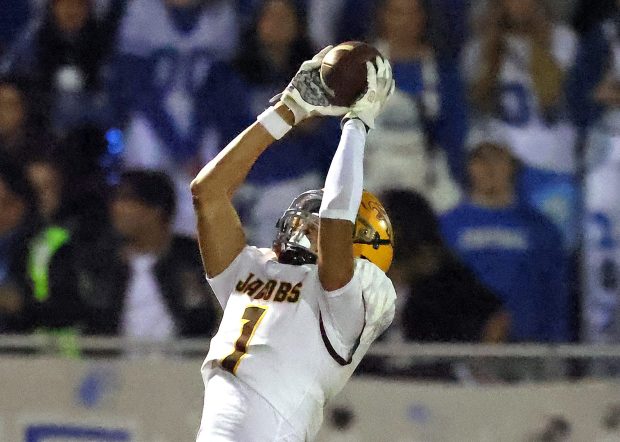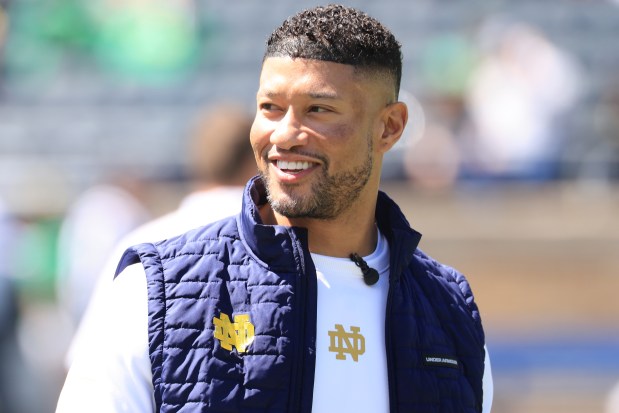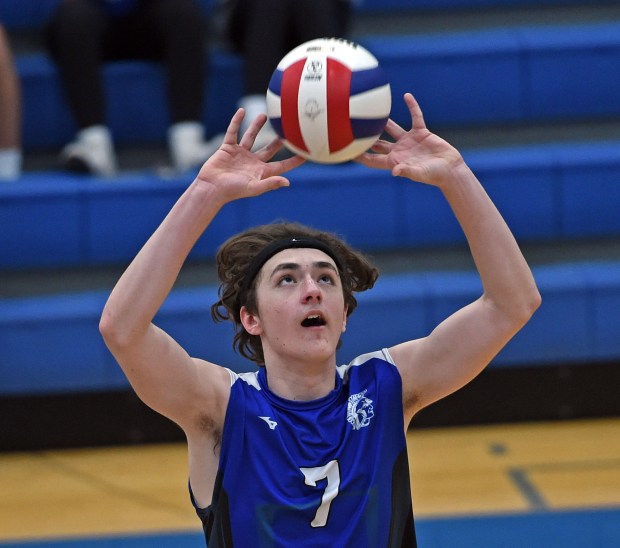The college sports world is still waiting for a resolution to the House vs. NCAA settlement nearly a month after a federal judge presided over the final approval hearing.
The $2.8 billion settlement, if approved, would benefit thousands of former and current college athletes. It would provide back pay to former athletes for missed name, image and likeness (NIL) opportunities. And it would allow current and future athletes — especially elite ones and those who participate in the money-making sports of football and men’s basketball — to benefit from revenue sharing from their universities.
But U.S. District Judge Claudia Wilken’s approval of the House settlement has been held up by one issue: roster limits.
The settlement would allow schools to increase the number of scholarships provided in most sports, but it also would set roster limits below what many teams carry.
In football, Division I programs would be allowed to increase the number of full scholarships provided from 85 to 105. However, football teams wouldn’t be able to carry more than 105 players — a significant reduction for teams that often field rosters of 120 or more thanks to walk-on players.
The possibility of such reductions has caused stress for many players across the country who occupy fringe roster spots — and for the coaches who have had to think about cutting them. Many athletes and their parents let Wilken know about such challenges through objection letters, and she listened.
Wilken first suggested during the final approval hearing April 7 that the NCAA and its power conferences — the Big Ten, SEC, ACC and Big 12 — consider revising the settlement to either phase in roster limits or grandfather in the roster spots of current players.
When the NCAA and power conferences declined that suggestion after the hearing, Wilken issued an ultimatum: Find a solution to the roster problem or lose approval of a settlement that has been in the works for years. She gave the parties 14 days to begin negotiating the issue, a deadline that arrives Wednesday.
“Judge Wilken has been the greatest champion for college athletes in this whole process,” said a Chicago-area mother of a Division I athlete. “As a graduate of a Power Four school, I am completely disgusted with how the Power Four is acting and how many of their athletic directors are acting (when it comes to roster limits). I am completely disgusted with the NCAA. I’m completely disgusted with the plaintiff attorneys, who are not representing everybody in the class of Division I athletes.”
Understanding the math
If the NCAA and power conference leaders can come up with a solution Wilken accepts, it would end nearly a year of uncertainty for many athletes, especially those in non-revenue-generating sports and those who hold walk-on or partial-scholarship roster spots.
Some teams trimmed their rosters early to get ahead of the issue, with many reports surfacing in the fall of athletes being cut or recruits having their offers withdrawn. But some athletes with fringe roster spots have spent months wondering whether they will have a place on their teams next year.
The mother of the Division I athlete, who participates in a spring sport, said her son has been nervous about his roster spot, and the knowledge that cuts might be on the horizon has created a difficult dynamic on the team. Some players worried about losing their places. Others felt guilty knowing they would have a spot over a teammate.
The coach was upfront with his players — and vocal against the limits — but it still created what she called “a cloud over his team.”
“It’s been really hard for the team because they understand the math,” said the mother, who asked not to be named because of the changing nature of her son’s spot on the team. “Kids and teams are used to the competition embedded for playing time or starting roles, but the idea of viewing your teammate as, ‘It’s me or him for next year,’ is not something that any of them signed up for or have really had to do before.
“They keep saying things like, ‘Well, next year — hopefully, if I’m back.’ … It’s just so much to put on a bunch of 18- and 19-year-olds.”
Noah Henderson, director of the sport management program at Loyola’s Quinlan School of Business, has been a vocal critic of the proposed roster limits.
After the preliminary approval of the settlement, Henderson — a former golfer at Saint Joseph’s in Philadelphia — looked at how many roster spots might be eliminated, first examining SEC baseball teams and Football Bowl Subdivision teams. His conclusion, which he wrote for Sports Illustrated, was that more than 100 SEC baseball spots could be lost with a 34-player limit, and potentially thousands of spots could be lost at the highest level of football.
Henderson published more articles for SI on potential effects of the House settlement, and he also took his concerns directly to Wilken via objection letters about the roster limits.
“I was a student-athlete myself,” he told the Tribune. “I know how hard anyone works to get there, whether you’re playing important minutes or you are someone who shows up to lift and practice every day fighting to make the team better. No one is on a D-I roster by luck. Everyone worked really hard to get there, and it felt like in a lot of the talk about these roster limits, that wasn’t necessarily reflected.”
Henderson was far from the only person to voice his objections to Wilken. Dozens of athletes, their parents and advocates wrote letters explaining how the roster uncertainty affected them, including many in April before Wilken issued the decree that attorneys needed to find a solution before she would grant approval.
“I think people’s voices are really powerful in this,” the athlete’s mother said. “I think people’s outcry is part of what pushed this judge to make this stand. … All of a sudden she gets 120 letters in one day, that is a powerful thing.”
Planning ahead
The uncertainty hasn’t been easy for coaches either. Many are trying simultaneously to get their rosters in order and do right by the athletes who may or may not be cut — while also allowing for the possibility they could keep those players around.
Illinois football coach Bret Bielema said during his news conference at the end of spring practice that he has one plan if the NCAA limits rosters to 105 players and another if teams can have 115 to 120. Bielema, who does exit interviews with each player every fall and spring, said he tried to be “upfront and honest” about where they stood in each scenario.
“I shared that with every kid,” Bielema told reporters. “As soon as we have any information, I update them with that. … The one thing as a coach, I promise you, I’m a couple steps ahead of where reality is all the time.”
Bielema didn’t advocate for a 105 limit, but he likes the idea of a uniform number across college football to even the playing field, however it plays out. He said recruiting has been “for lack of a better term, a s−−−show” recently.
“The more we can get that (number) streamlined, the better the world will be,” he said.

Some college athletes didn’t wait to see how it pans out and entered their sport’s transfer portal.
Illinois walk-on tight end Nick True said Bielema brought up the roster limits to him, but he already had decided to transfer, believing that “what I was showing on tape and what I was proving to the coaches, I just wasn’t getting the opportunity I felt like I’ve shown I deserve.” He is looking at smaller programs where he can be more confident he’ll get on the field and said he has offers from Ball State and Illinois State.
True, from Jacobs High School in Algonquin, said he knows other players who entered the portal after talking with Bielema amid the murky future of their spots.
“Being in that position is hard for them, wanting to pursue their football dreams,” True said. “But getting all of this last minute and trying to find a new school is obviously not going to work out for a lot of them. It is definitely tough for a lot of them.”
Notre Dame football coach Marcus Freeman indicated to reporters this spring he was taking a similar approach to Bielema, formulating a plan for 105 players and another if the Irish can carry more.

Irish wide receiver Alex Whitman was among the walk-ons who wrote a letter to Wilken. He noted how walk-ons participate for the love of the game, their team and their school, often taking on unsung roles on the scout team to contribute in whatever way they can.
“If the proposed settlement goes through as is, it means that I could be cut,” Whitman wrote. “I would be left with two undesirable options, leave my dream university where I invested so much time and energy or stay and watch from the sidelines as my eligibility quietly disappears, essentially forcing me to choose between student or athlete.
“It feels like everything I have worked for is being taken away, not because of merit but because of the decisions of a few who prioritize money over people.”
Henderson advocated in one of his letters and in an ensuing SI story for the implementation of practice squads. His reasoning was the House settlement already is serving as a “de facto” collective bargaining agreement — including a salary cap of sorts that would be about $20.5 million per school in the first year — without the NCAA and its schools having to recognize their athletes as employees.
Why not emulate professional sports and try to save some roster spots by creating practice squads?
“I looked at this and saw we were moving toward a professional model of sports,” Henderson said. “And that’s something common in professional sports is you have some developmental system, a farm team or minor-league system — or taking the model from football, a practice squad — where you can still have more players on a roster.
“In football, there are a lot of injuries. There’s a reason schools are carrying 123 guys.”
A Yahoo Sports report last week said a plan is in the works to grandfather in current roster spots and phase in the limits, and an attorney for the defendants told The Associated Press on Monday that he believes the agreement “will solve the judge’s concerns.”
If a such a proposal is agreed upon, the issues for football walk-ons could be solved temporarily. But many questions remain about the future reduction of Division I roster spots.
Future challenges

Former Wheaton St. Francis volleyball player Kyle Zediker already had moved out after his first year at Grand Canyon University in Phoenix and was at home in Illinois when he received the news.
Zediker was on FaceTime with a teammate, who was attending what they thought was a compliance meeting. Instead, Grand Canyon officials let the men’s volleyball team know the program was being cut just a year after it made the NCAA Tournament semifinals.
“It was pretty sad,” Zediker said. “It’s tough to have to go there for one year and then leave all my friends and connections that I made at that school behind. We really did have a great thing going there, a really good young core moving forward for volleyball. So it is really sad to know all that has to be left behind.”
The team received no warning that such news was coming.
Over the phone, Zediker strained to understand the reasoning, which to the best of his knowledge was “a business decision.” Grand Canyon, which announced in March it would opt into the House settlement, cited the low number of Division I men’s volleyball teams and said it would reallocate funds to its other programs. The university said it will honor existing scholarships and field a club men’s volleyball team.
“In a rapidly evolving college athletics landscape, GCU is constantly evaluating how it can best position itself as a Division I athletic department and a university,” the school said in a statement. “The move will allow GCU to focus on supporting its remaining 20 athletic programs at the highest levels in their respective conferences.”
The American Volleyball Coaches Association responded with a statement expressing its “deep concern” with the program’s elimination. It said that in the changing world of college sports, “these challenges must not be met with the reduction of opportunities that transform lives and communities.”
The situation underscores the potential danger to non-revenue-generating sports. For some universities, that might be the elimination of entire programs as athletic departments figure out how to allocate funds in the revenue-sharing era. And for some, it could mean the aforementioned roster trims.
Zediker, a setter who had 219 assists in his first season, is in the transfer portal and expects to move fairly quickly on his next opportunity. He has been struck by the amount of support he has received — including from the Grand Canyon coaches who lost their jobs — as he tries to find a new home.
But he’s worried about some of his teammates who might have trouble latching on to a new team, especially with the roster situation in flux.
“Especially people who maybe didn’t get a ton of playing time, maybe they didn’t play at all,” Zediker said. “If they’re going in the portal, it’s really tough for those guys to find new homes just because it’s hard for college coaches to take someone that has no film.
“So knowing that some of my teammates are in that situation, but they’re very good volleyball players, it’s really tough to see that because they’re so deserving of a spot and they’re amazing people. But it’s just the way the landscape of men’s volleyball is going right now and how the NCAA is changing.”
If the roster limits are phased in and/or current players are grandfathered in, it could help athletes in the 2025-26 school year. But eventually Division I opportunities may decrease in all sports.
Two area high school football coaches noted to the Tribune that recruiting opportunities for many of their players already have diminished because of the transfer portal. Wiping out perhaps thousands of roster spots would make it worse, and high school athletes would have to continue to adjust their expectations for which collegiate level they can play.
Henderson argued that a temporary solution at least would allow time for the roster restructuring to play out naturally.
“I don’t think it will have as drastic an impact if you amortize this over a few years,” he said. “What you’ll likely see is conferences like the Ohio Valley and the Missouri Valley get strong athletes. … You’re going to see talent be dispersed in a different way.
“The issue (right now) is the shock to the system. If you put 10,000 athletes in the transfer portal in one year, it’s going to upend (a lot). If you do it gradually, you can allow talent to more naturally find a home and sort of rebound.”



